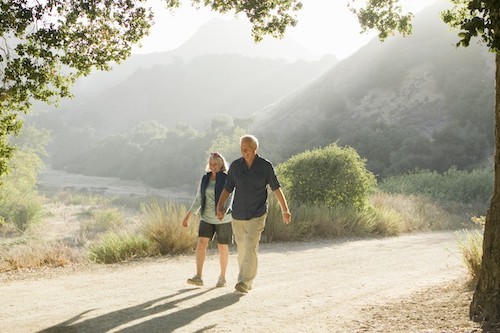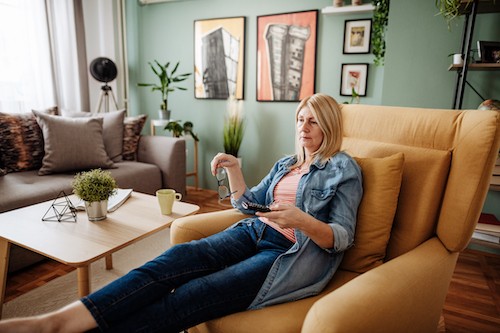Age
Age is the most significant risk factor for varicose veins, and also a risk factor for which there is no solution[1]. As you age, the connective tissues in your veins become weaker, and your body’s ability to produce collagen and elastin, the proteins that form these connective tissues decreases, leading to poorer quality structural proteins. As a result, your blood vessels become stiffer and less able to accommodate normal fluctuations in blood flow. Also, we tend to become more sedentary with advanced age which carries its own risk factors. However, if you are physically able to remain active this part of the aging process is largely under your control.

Age is also tied to gender in terms of its effect on risk for varicose veins, with women experiencing a greater increase in risk as well as more symptoms if they develop varicose veins as they age compared to men[1]. Past the age of 65, women have been found to have an 83% chance of having of developing varicose veins, about 28% greater likelihood than men of the same age range[1].
Obesity
It’s common knowledge that being overweight puts you at greater risk for conditions like high blood pressure, heart disease, and diabetes. Being overweight also increases your risk for varicose veins and if you are obese and develop varicose veins you are more likely to have symptoms than someone with varicose veins who isn’t overweight[2].
Obesity is associated with chronic low-grade inflammation, which fans the flames of varicose veins by causing changes in blood vessel linings that lead to further impaired blood flow[2]. Additionally, if you are obese and have varicose veins you are more likely to experience ulcers, or open sores in the skin, which are a serious complication of venous disease that can be slow to heal and challenging to treat[2]. Ulcers are more likely to recur in obese varicose vein patients, as well[2].
Genes
Researchers have identified hundreds of genes and genetic variants that are associated with increased risk for varicose veins. Genetic variability between individuals has a significant impact – about 60% on risk for varicose veins[3]. If both of your parents have varicose veins you have a 90% chance of developing varicose veins at some time in your life[3]. If one of your parents is affected, your risk is 25% if you are male and 62% if you are female[3].
Some of the strongest genetic links have to do with genes involved with regulating blood pressure and genes involved in the development of your vascular system[4]. There is also strong genetic evidence showing that if you’ve ever had a blood clot in your leg you are at increased risk for developing varicose veins[4]. Genes that regulate vascular development may make some people more susceptible to impaired blood flow. There are also genetic variants that make some people’s blood more prone to clotting[4].

Pregnancy
Pregnancy contributes greatly to the increased risk for varicose veins in women. About 40% of women develop varicose veins during pregnancy and for the great majority of these women, varicose veins appear in the first trimester often as early as the first few weeks[5]. Additionally, after two or more pregnancies, a woman’s risk for developing varicose veins later on increases by 20% - 30%[3].
There are several factors unique to pregnancy that are responsible for this increased risk:
- Hormones released during pregnancy, particularly progesterone, make the veins more expandable and this places stresses on veins and makes it more difficult to move blood back to the heart[5].
- Increased blood volume in pregnancy places added physical stress on blood vessels[5].
- As the baby grows, the increased weight within the mother’s pelvis compresses pelvic veins, increasing blood pressure in the leg veins[5].
- Estrogen and progesterone receptors in the large veins of the legs are thought to contribute to the dilation of the veins and impaired function of the vein valves[5].
Sedentary Lifestyle
Having a sedentary lifestyle is a major risk factor for varicose veins. The easiest way to understand the effects of a sedentary lifestyle on the health of your veins is to consider the benefits of an active lifestyle that you are not taking advantage of when you are sedentary. There are many important health benefits to be gained by exercising regularly and several of them directly or indirectly improve the health of your veins and decrease your risk for developing varicose veins.

Firstly, exercise gets your blood flowing – that means not just the blood flow to your muscles, heart, and lungs, but the blood flow in your veins, as well. Exercises that use your leg muscles are especially helpful for promoting circulation in the leg veins. Also, regular exercise also helps you maintain a healthy weight, which can reduce your risk for varicose veins by preventing high blood pressure, and it strengthens your muscles, which are a necessary component of healthy venous circulation by virtue of their gentle massaging effect on the veins that helps push blood through them. Finally, exercise can help lift your mood, which can help you stay motivated to exercise more. If you have a sedentary lifestyle you are missing out on these preventive benefits and increasing your risk for varicose veins.
All of these risk factors are important to understand, but the only way to effectively treat varicose veins is to seek professional vein treatment. The minimally invasive varicose and spider vein treatment options at Desert Vein and Vascular Institute can ensure your vein issues have been handled correctly.
To learn more about your individual risk factors for varicose veins we invite you to schedule a free consultation at Desert Vein and Vascular Institute. All of our physicians are board-certified vascular surgeons who specialize in helping people like you. Desert Vein and Vascular Institute is the top provider of VenaSeal™, the leading outpatient varicose vein treatment, in the USA.
To schedule a free consultation, please call 1-800-827-4267 today or contact us.
References
- The influence of age and gender on venous symptomatology. An epidemiological survey in Belgium and Luxembourg. Phlebology, 2016. 31(5): p. 325-33
https://pubmed.ncbi.nlm.nih.gov/26036248/ - Obesity and lower limb venous disease - The epidemic of phlebesity. Phlebology, 2017. 32(4): p. 227-233
https://pubmed.ncbi.nlm.nih.gov/27178403/ - The influence of environmental factors in chronic venous insufficiency. Angiology, 2003. 54 Suppl 1: p. S19-31
https://pubmed.ncbi.nlm.nih.gov/12934754/ - Clinical and Genetic Determinants of Varicose Veins. Circulation, 2018. 138(25): p. 2869-2880
https://pubmed.ncbi.nlm.nih.gov/30566020/ - Interventions for varicose veins and leg oedema in pregnancy. Cochrane Database Syst Rev, 2015. 2015(10): p. Cd001066
https://pubmed.ncbi.nlm.nih.gov/26477632/
